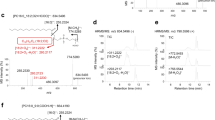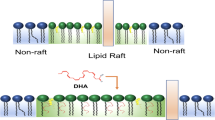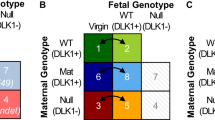Abstract
Docosahexaenoate is usually considered to be the principal endpoint of α-linolenate metabolism in mammals. Nevertheless, several studies over the past 30 y have shown that more carbon from α-linolenate is recycled into newly synthesized lipids than is used to make docosahexaenoate. Our objective in this study was to assess carbon recycling from α-linolenate in suckling rats made deficient in n-3 polyunsaturated fatty acids (PUFA). Female Long-Evans rats were given a diet deficient in n-3 PUFA at weaning and then bred 8 wk later. Pups from the second generation were nursed by their respective dams and gavaged with 1 mg [U-13C]-α-linolenate at 10 d old. Brain and liver were obtained 24 h later, and the fatty acid profiles and 13C enrichment analyzed. Docosahexaenoate was markedly depleted in brain (−82%) and liver (−97%) of the n-3 PUFA–deficient rats. In the controls, 13C enrichment in products of carbon recycling (cholesterol and fatty acids other than n-3 PUFA) exceeded that in docosahexaenoate by 2.4-fold (liver) and 7.5-fold (brain). n-3 PUFA deficiency reduced the ratio of 13C enrichment in products of carbon recycling compared with 13C incorporated into docosahexaenoate by 63% in the brain but not in the liver. Despite severe n-3 PUFA deficiency, carbon recycling still consumed 50% more 13C from α-linolenate than went into docosahexaenoate in the liver and 2.8-fold more in the brain. We conclude that carbon recycling is an integral part of neonatal metabolism of α-linolenate and is not simply an overflow pathway arising from excess availability of preformed docosahexaenoate.
Similar content being viewed by others
Log in or create a free account to read this content
Gain free access to this article, as well as selected content from this journal and more on nature.com
or
Abbreviations
- GC:
-
gas chromatograph(y)
- PUFA:
-
polyunsaturated fatty acid(s)
References
Cunnane SC, Yang J 1995 Zinc deficiency impairs whole-body accumulation of polyunsaturates and increases the utilization of [1-14C]linoleate for de novo lipid synthesis in pregnant rats. Can J Physiol Pharmacol 73: 1246–1252
Cunnane SC, Anderson MJ 1997 The majority of dietary linoleate in growing rats is β-oxidized or stored in visceral fat. J Nutr 127: 146–152
Sinclair AJ 1975 Incorporation of radioactive polyunsaturated fatty acids into liver and brain of the developing rat. Lipids 10: 175–184
Dhopeshwarkar GA, Subramanian C 1975 Metabolism of α-linolenic acid in developing brain.I. Incorporation of radioactivity from [1-14C]-α-linolenic acid into brain fatty acids. Lipids 10: 238–241
Dhopeshwarkar, Subramanian C 1975 Metabolism of α-linolenic acid in developing brain. II. Incorporation of radioactivity from [1-14C]-α-linolenic acid into brain lipids. Lipids 10: 242–247
Menard CR, Goodman KJ, Corso TN, Brenna JT, Cunnane SC 1998 Recycling of carbon into lipids synthesized de novo is a quantitatively important pathway of α-[U-13C]-linolenate utilization in the developing rat brain. J Neurochem 71: 2151–2158
Cunnane SC, Ryan MA, Nadeau CR, Bazinet RP, Musa-Veloso K, McCloy U 2003 Why is carbon from some polyunsaturates extensively recycled into lipid synthesis?. Lipids 38: 477–484
Williard DE, Harmon SD, Kaduce TL, Preuss M, Moore SA, Robbins ME, Spector AA 2001 Docosahexaenoic acid synthesis from n-3 polyunsaturated fatty acids in differentiated rat brain astrocytes. J Lipid Res 42: 1368–1376
Demar JC Jr, Ma C, Chang L, Rapoport SI 2005 alpha-Linolenic acid does not contribute appreciably to docosahexaenoic acid within brain phospholipids of adult rats fed a diet rich in docosahexaenoic acid. J Neurochem 94: 1063–1076
Sheaff Greiner RC, Zhang Q, Goodman KJ, Guissani DA, Nathanielsz PW, Brenna JT 1996 Linoleate, α-linolenate and docosahexaenoate recycling into saturated and monounsaturated fatty acids is a major pathway in pregnant or lactating adults and fetal or infant rhesus monkeys. J Lipid Res 37: 2675–2686
Burdge GC, Wootton SA 2003 Conversion of α-linolenic acid to palmitic, palmitoleic, stearic and oleic acids in men and women. Prostaglandins Leukot Essent Fatty Acids 69: 283–290
Cunnane SC, Belza K, Anderson MJ, Ryan MA 1998 Substantial carbon recycling from linoleate into products of de novo lipogenesis occurs in rat liver even under conditions of extreme linoleate deficiency. J Lipid Res 39: 2271–2276
Salem N Jr, Litman B, Kim HY, Gawrisch K 2001 Mechanisms of action of docosahexaenoic acid in the nervous system. Lipids 36: 945–959
Salem N Jr 1989 Omega-3 fatty acids: molecular and biochemical aspects. In: Spiller G, Scala J (eds) New Protective Roles of Selected Nutrients in Human Nutrition. Alan R. Liss, New York, pp 109–228
Lim SY, Doherty JD, McBride K, Miller-Ihli NJ, Carmona GN, Stark KD, Salem N Jr 2005 Lead exposure and (n-3) deficiency during rat neonatal development affect subsequent spatial task performance and olfactory discrimination. J Nutr 135: 1019–1026
McCloy U, Ryan MA, Pencharz PB, Ross RJ, Cunnane SC 2004 A comparison of the metabolism of eighteen-carbon 13C-unsaturated fatty acids in healthy women. J Lipid Res 45: 474–485
Moriguchi T, Loewke T, Garrison M, Catalan JN, Salem N Jr 2001 Reversal of docosahexaenoic acid deficiency in the rat brain, retina, liver and serum. J Lipid Res 42: 419–427
Moriguchi T, Salem N Jr 2003 Recovery of brain docosahexaenoate leads to recovery of spatial task performance. J Neurochem 87: 297–309
Su HM, Bernardo L, Mirmiran M, Ma XH, Corso TN, Nathanielsz PW, Brenna JT 1999 Bioequivalence of dietary α-linolenic and docosahexaenoic acids as sources of docosahexaenoate accretion in brain and associated organs of neonatal baboons. Pediatr Res 45: 87–93
Lefkowitz W, Lim SY, Lin Y, Salem N Jr 2005 Where does the developing brain obtain its docosahexaenoic acid? Relative contributions of dietary alpha-linolenic acid, docosahexaenoic acid and body stores in the developing rat. Pediatr Res 57: 157–165
Acknowledgements
This study was supported by the NIAAA Intramural Research Program (Y.H.L., S.Y.L., and NS) and by NSERC (S.C.C. and M.A.R.).
Author information
Authors and Affiliations
Corresponding author
Rights and permissions
About this article
Cite this article
Cunnane, S., Ryan, M., Lin, Y. et al. Suckling Rats Actively Recycle Carbon from α-Linolenate into Newly Synthesized Lipids Even During Extreme Dietary Deficiency of n-3 Polyunsaturates. Pediatr Res 59, 107–110 (2006). https://doi.org/10.1203/01.pdr.0000190569.07991.ed
Received:
Accepted:
Issue date:
DOI: https://doi.org/10.1203/01.pdr.0000190569.07991.ed
This article is cited by
-
A High‐Fat, High‐Oleic Diet, But Not a High‐Fat, Saturated Diet, Reduces Hepatic α‐Linolenic Acid and Eicosapentaenoic Acid Content in Mice
Lipids (2016)
-
Fatty acid patterns early after premature birth, simultaneously analysed in mothers' food, breast milk and serum phospholipids of mothers and infants
Lipids in Health and Disease (2009)
-
Markedly raised intake of saturated and monounsaturated fatty acids in rats on a high‐fat ketogenic diet does not inhibit carbon recycling of13C‐α‐linolenate
Lipids (2006)



